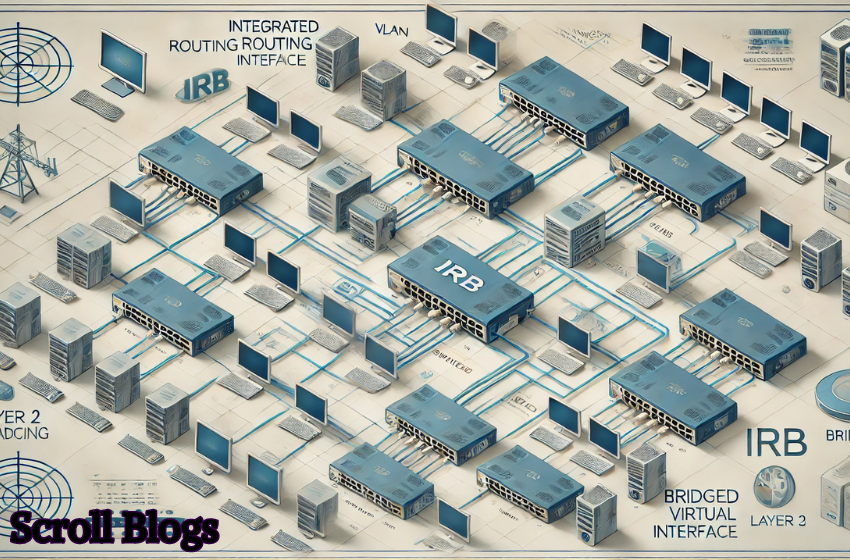What is Integrated Routing and Bridging?
Integrated Routing and Bridging (IRB) is a powerful networking technique that combines the functionalities of Layer 2 switching (bridging) and Layer 3 routing. This integration allows a network device to forward packets within a VLAN (Virtual Local Area Network) at Layer 2 and between VLANs at Layer 3, using a single interface. This hybrid approach is essential for modern networks where efficiency, flexibility, and scalability are paramount.
The Role of Bridged Virtual Interface (BVI)
At the core of integrated routing and bridging is the Bridged Virtual Interface (BVI). The BVI serves as the Layer 3 interface for a group of bridged interfaces. When a packet arrives on a routed interface destined for a segment within a bridge group, it is routed to the BVI, which then forwards it through the bridging engine. This process ensures that traffic is managed efficiently, leveraging both routing and bridging capabilities.
Configuration of BVI
Configuring a BVI involves several steps:
- Creating VLANs: Begin by defining the VLANs and assigning unique VLAN IDs to each. This step is crucial as it sets up the foundation for segregating network traffic.
- Assigning Interfaces: Next, map physical interfaces to the corresponding VLANs. This involves configuring the network interfaces to participate in the appropriate VLANs, ensuring that each VLAN has the necessary ports assigned.
- Linking to BVI: Finally, associate the VLANs with a BVI. This BVI is configured with an IP address, allowing it to handle routing duties. By linking VLANs to a BVI, the network can efficiently manage traffic flow both within and between VLANs.
Advantages of Integrated Routing and Bridging
Integrated routing and bridging offer numerous advantages for network design and management:
- Efficiency: By combining routing and bridging, networks can significantly reduce the number of devices needed. This reduction not only lowers initial setup costs but also decreases ongoing maintenance and management complexity.
- Flexibility: Networks configured with IRB can be easily reconfigured to adapt to changing requirements. Whether scaling up to accommodate more devices or adjusting to new traffic patterns, IRB provides the flexibility needed without requiring major hardware changes.
- Scalability: IRB supports scalable network designs, making it easier to handle growth in both the number of devices and the volume of traffic. This scalability ensures that the network can expand smoothly as organizational needs evolve.
Practical Applications of IRB
Data Centers
In data centers, IRB is used to manage traffic efficiently. It allows for seamless communication between VLANs while maintaining the isolation of different network segments. This is crucial for data centers that host multiple clients or services, ensuring security and performance.
Enterprise Networks
Enterprises benefit from IRB by simplifying their network architecture. Integrated routing and bridging reduce the need for multiple devices, streamline management, and improve network performance. This is especially useful in large office environments with numerous departments and varying network requirements.
Service Provider Networks
Service providers use IRB to offer isolated yet interconnected services to their customers. By leveraging integrated routing and bridging, they can maintain high levels of security and performance, ensuring customer satisfaction.
Configuration Examples
Cisco IRB Configuration
On Cisco devices, IRB can be configured with the following steps:
- Create VLANs: Define VLANs with
vlancommands. - Assign Interfaces: Use
interfacecommands to assign physical interfaces to VLANs. - Configure BVI: Create a BVI with an IP address using
interface BVIcommands.
Juniper IRB Configuration
For Juniper devices, the configuration involves:
- Create VLANs: Define VLANs and assign IDs using
set vlans. - Assign Interfaces: Use
set interfacesto map interfaces to VLANs. - Link to IRB: Create and link a logical Layer 3 IRB interface with
set interfaces irb.
Challenges and Considerations
While IRB offers many benefits, there are also challenges to consider:
- Complexity: Properly configuring and managing IRB can be complex, requiring thorough understanding and careful planning.
- Compatibility: Not all devices or network environments support IRB, necessitating compatibility checks and potential upgrades.
- Troubleshooting: Diagnosing issues in a network using IRB can be more complex due to the integration of Layer 2 and Layer 3 functionalities.
Conclusion
Integrated routing and bridging represent a sophisticated approach to modern network design, combining the best aspects of routing and bridging to create efficient, flexible, and scalable networks. Whether in data centers, enterprise environments, or service provider networks, IRB plays a crucial role in ensuring seamless communication and robust performance.
Incorporating IRB into your network design can lead to significant improvements in efficiency and scalability. However, it requires careful planning, configuration, and management to realize its full potential. As network demands continue to evolve, integrated routing and bridging will remain a key strategy for optimizing network performance and meeting the challenges of modern networking.

